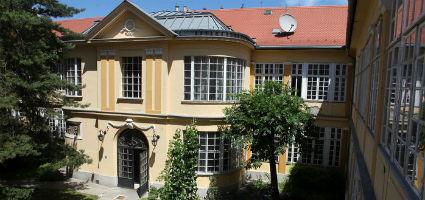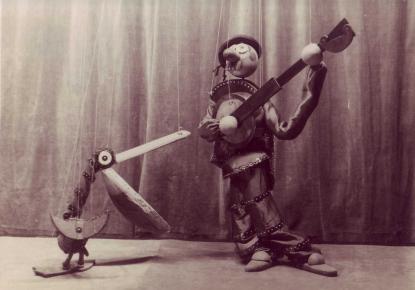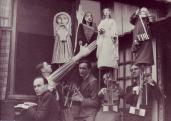2024. May 4. Saturday
National Theatre Historical Museum and Institute - Budapest
 |
Address: 1013, Budapest Krisztina körút 57.
Phone number: (1) 375-1184
E-mail: oszmi@szinhaziintezet.hu
Opening hours: Mon, Wed-16
|
The exhibition has closed for visitors.
2015.03.20. - 2015.04.30.
Although Hungary's state honours rewarding outstanding puppet artists has borne his name since 2002, few people know who was Géza Blattner (1893-1967) and why he was appointed by the Hungarian and world puppet show literature the father of modern European puppetry.

During his work of forty years, he continuously searched for the potential new artistic and technical possibilities in puppetry. Between 1918 and 1958 he set up twelve puppet show stages ranging from simple portable screens to more sophisticated stages.
In 1925 he moved to Paris. Together with fine and applied artist Hungarians living in Paris he began the Puppet Theatre Arc-en-Ciel (Rainbow) in 1929. They did not commit themselves to any puppet moving models. They used variable material to every and each of he shows. Their new-style performances have won international success, the Arc-en-Ciel became chief pilot of modern European puppetry workshop. At the Paris expo in 1937, the Puppet Theatre Arc-en-Ciel won golden medal with the show 'Man's Tragedy' written by Imre Madách.
The shadowy figures of different systems. Variations of keyboards and string marionettes, , masks and abstract puppets became outstanding results on the experimental path that Géza Blattner took.
His efforts were intended to prove the legitimacy of puppetry, the recognition of its significance.
Memory of his career and his theatre are kept alive by the National Theatre Museum and Institute. As hos heritage contained very few puppets but a lot of photos, among them valuable takes like those by André Kertész the exhibition is based on photo enlargements, but original invitations, autobiographical slide shows hand-painted by Géza Blattner will be presented. In addition, the exhibition also presents special keyboard puppet reconstructions that Géza Blattner developed.
The curator Emese Stenczel

During his work of forty years, he continuously searched for the potential new artistic and technical possibilities in puppetry. Between 1918 and 1958 he set up twelve puppet show stages ranging from simple portable screens to more sophisticated stages.
In 1925 he moved to Paris. Together with fine and applied artist Hungarians living in Paris he began the Puppet Theatre Arc-en-Ciel (Rainbow) in 1929. They did not commit themselves to any puppet moving models. They used variable material to every and each of he shows. Their new-style performances have won international success, the Arc-en-Ciel became chief pilot of modern European puppetry workshop. At the Paris expo in 1937, the Puppet Theatre Arc-en-Ciel won golden medal with the show 'Man's Tragedy' written by Imre Madách.
The shadowy figures of different systems. Variations of keyboards and string marionettes, , masks and abstract puppets became outstanding results on the experimental path that Géza Blattner took.
His efforts were intended to prove the legitimacy of puppetry, the recognition of its significance.
Memory of his career and his theatre are kept alive by the National Theatre Museum and Institute. As hos heritage contained very few puppets but a lot of photos, among them valuable takes like those by André Kertész the exhibition is based on photo enlargements, but original invitations, autobiographical slide shows hand-painted by Géza Blattner will be presented. In addition, the exhibition also presents special keyboard puppet reconstructions that Géza Blattner developed.
The curator Emese Stenczel

